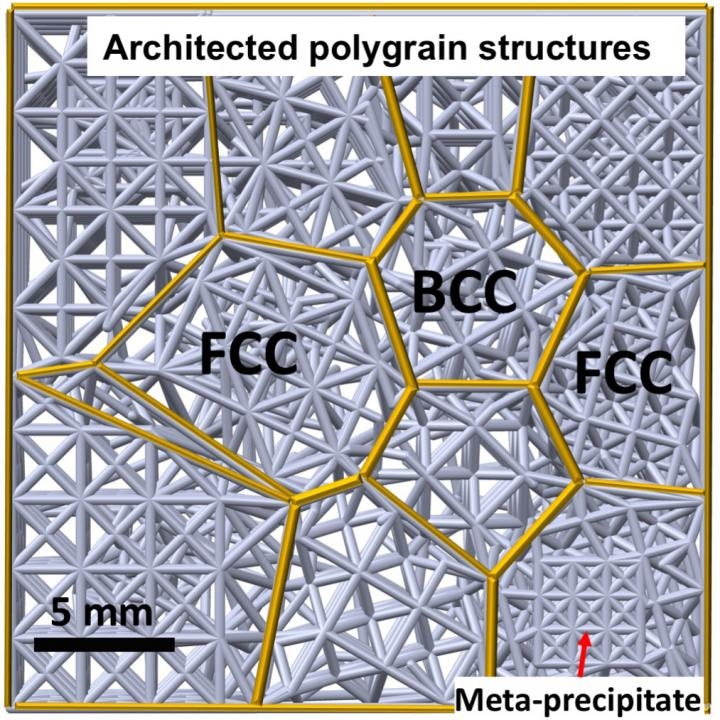Jan 18 2019
Professor Iain Todd from the Department of Materials Science and Engineering at the University of Sheffield has worked jointly with collaborators from Imperial College London to take a new approach to the development of engineering components created using additive manufacturing.
 Schematic of polygrain structures, taken from Damage-tolerant architectured materials inspired by polycrystals. (Image credit: Minh-Son Pham, Chen Liu, Iain Todd, Jedsada Lertthanasarn, Nature, January 17th, 2019)
Schematic of polygrain structures, taken from Damage-tolerant architectured materials inspired by polycrystals. (Image credit: Minh-Son Pham, Chen Liu, Iain Todd, Jedsada Lertthanasarn, Nature, January 17th, 2019)
Additive manufacturing (AM) is also called 3D printing and is frequently used to manufacture engineering components. These components make use of lattice structures to replace solid materials and thus are considerably lighter when compared to their solid counterparts and can be produced in such a way that they also display property combinations that cannot be exhibited by traditional solids. These structures are called architected materials.
Generally, these lattice structures have a uniform layout with all nodes compliant with a regular array, where all the struts between the nodes follow common planes: and the issue lies here.
The study, featured in Nature magazine on January 17th, 2019, describes how these uniform lattices reproduce the structure of a metallic single crystal: the AM lattice nodes are similar to the atoms in the single crystal and the struts are similar to the atomic bonds. All the atomic planes or nodes are in perfect alignment in each of these structures.
For certain applications, for example, in the high-temperature end of a jet engine, single crystal materials are appropriate because they can endure deformation at extreme temperatures; however, they have drawbacks associated with their mechanical performance. This drawback is also seen in AM parts with a uniform lattice structure.
Upon subjecting the structure to compression, the lattice shears along one or more of the planes of nodes as soon as the force becomes adequate enough to cause permanent deformation. The collapse turns catastrophic as there is nothing to hinder this shearing.
In polycrystalline materials—which have many crystals—the atomic planes are aligned randomly; therefore, when a shear force is along a specific direction, a crack will decelerate or halt when it comes across a crystal where the atoms are aligned in a manner different from the crystal where the crack started. Furthermore, various materials can be introduced in the form of precipitates, phases, or inclusions used to make the materials stronger; these materials also help to slow down crack propagation.
This basic metallurgical understanding motivated researchers at Imperial College London and the University of Sheffield to simulate polycrystalline microstructures in AM lattices with the goal of creating robust, damage-tolerant architected materials.
With the computer modeling of atomic structures, improving them, and forming meso-structures based on polycrystalline materials, engineers have been revolutionizing the way the materials are designed, which have been termed “meta-crystals.”
Experimental investigation of components created from these meta-crystals has shown that they are highly energy absorbent, where the polycrystal-like material has the ability to withstand nearly seven times the energy prior to failure when compared to the materials that emulate the single-crystal structure.
Although the fundamental metallurgical concepts are being used to instigate the development of architected materials, scientists are adopting the creation of architected materials as an alternative method to analyze complex metallurgical phenomena.
This approach to materials development has potentially far-reaching implications for the additive manufacturing sector. The fusion of physical metallurgy with architected meta-materials will allow engineers to create damage-tolerant architected materials with desired strength and toughness, while also improving the performance of architected materials in response to external loads. And while these materials can be used as standalone structures, they can also be infiltrated with other materials in order to create composites for a wide variety of applications.
Professor Iain Todd, Department of Materials Science and Engineering, The University of Sheffield
This meta-crystal approach could be combined with recent advances in multi-material 3D printing to open up a new frontier of research in developing new advanced materials that are lightweight and mechanically robust, with the potential to advance future low carbon technologies.
Dr Minh-Son Pham, Imperial College London